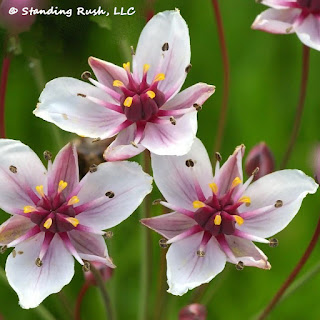 |
| Clusters of a dozen or more flowers -- each about an inch across and suspended from an umbrella-like network of stems -- introduce both vibrant color and the risk of an unwanted invasion |
When we began our field work in 2015, Flowering Rush (or "F-ing Rush," as some prefer to affectionately refer to it) seemed very limited, at least in our corner of Sandusky Bay. We can remember isolated plants in a ditch area that fluctuated from inundated to dry multiple times throughout that first season.
But as water levels have continued to rise and hold, not just locally but across the Bay, Lake Erie, and all of the Great Lakes, we've seen what seems to be a sustained proliferation of the glossy-leaved plant all around us -- and unfortunately, to some extent, within our marshes' boundaries.
While the surface area impacted remained relatively modest in 2018 (under a single percent of our overall area), Flower Rush eradication became Job #1 for Roy last June - August. Many a hot day was spent scouting and spraying. Unfortunately, mechanical control (e.g., cutting or pulling) only amplifies the problem thanks to scores of stubborn "bulbils," or bulb-like propagules that grow within the root structure. A backpack sprayer (equipped with a cocktail of glyphosate, imasapyr, and a surfactant ) did the job for individual plants and small, isolated pockets that typically hugged dikes and canals. But on a few occasions, we actually tag-teamed to carefully apply herbicide both by backpack and by boat (equipped with a battery-powered ATV sprayer tank).
 |
| Isolated plants (especially with flowers) became easy to identify and spray, but it seemed to take two discrete spray events, separated by at least a week or two, to achieve the desired result |
 |
| An example of what a FR looked like when it was ready for its second spray; two weeks later very little vegetation remained, at least above the water surface |
We have heard horror stories of Flowering Rush growing from depths of up to nine feet of water and in monocultures so thick and persistent that impacted areas -- sometimes hundreds of acres in size -- are virtually impenetrable. But we are seeing decent evidence that FR doesn't respond well to turbid water (a condition we can encourage, as needed) and that we have a herbicide technique that should be effective. So for now, we feel fairly optimistic that we are staying on top of the onslaught. It's another chapter in the invasive species saga.




